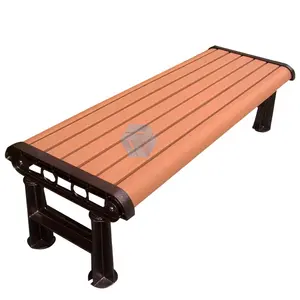

2023 Ends Used Park Benches For Sale Furniture Design With Bike Rack Curved Wooden Seats Wood Slats Backless Patio Garden Bench

Wholesale OEM ODM HDPE Recycled Plastic Slat Cast Aluminum Leg Backless Public Bench Outdoor Bench With Length Customized





















Backless benches, with their simplicity and understated elegance, have become versatile and popular outdoor seating solutions. These benches, characterized by their absence of a backrest, offer a minimalist design that seamlessly blends into various environments. From outdoor metal backless benches to small backless benches, each type serves a unique purpose while maintaining a sleek and unobtrusive aesthetic. In this exploration, we will delve into the types, usage scenarios, and materials used in making backless benches.
The choice of materials in making backless benches plays a significant role in their durability, aesthetics, and functionality. Wooden backless benches, often crafted from teak, cedar, or other weather-resistant hardwoods, offer a classic and natural appearance while withstanding outdoor elements. Metal, including materials like cast iron or aluminum, is commonly used in outdoor metal backless benches, providing a sleek and modern look with excellent durability. The Plastic backless bench, made from materials like recycled plastics, is lightweight, easy to clean, and resistant to weather-related wear. L-shaped backless benches may feature a combination of materials, with metal or wood for the frame and comfortable upholstery for the seating area. The Polywood backless bench, constructed from recycled plastics, showcases a commitment to sustainability without compromising on sturdiness.
Backless benches offer several advantages that contribute to their popularity. Their unobtrusive design makes them versatile in various outdoor settings, allowing them to blend into the natural surroundings or urban landscapes seamlessly. The absence of a backrest encourages flexible seating arrangements, accommodating more people and fostering a sense of openness. The simplicity of design often translates to ease of maintenance, making backless benches an attractive option for those seeking practical and low-maintenance outdoor seating solutions. Backless benches, with their minimalist design and practicality, have become essential elements in outdoor spaces. Whether it's the classic outdoor backless bench, the contemporary outdoor metal backless bench, the affordable plastic backless bench, the unique L-shaped backless bench, or the sustainable Polywood backless bench, each type caters to specific needs and preferences. These benches enhance public parks, gardens, urban squares, and private outdoor areas, offering comfortable seating options for relaxation and socializing. The choice of materials in their construction further adds to their appeal, providing a balance between durability, aesthetics, and sustainability. As we continue to appreciate the simplicity and versatility of backless benches, these unassuming pieces of outdoor furniture will likely remain cherished elements of our outdoor environments.